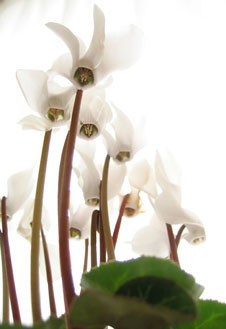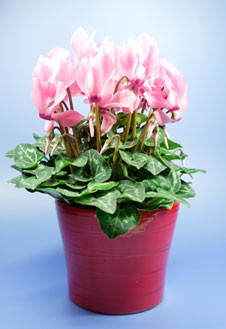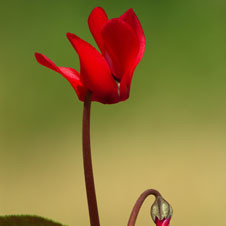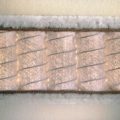 Cyclamen at homeThey look likebutterflies fluttering over silvery-green foliage. In European gardens, cyclamens are planted under large trees - they bring light and play into the shady twilight. But in our country they are more often grown as houseplants. Some people think that they are thrown away after flowering, but this is a misconception. Cyclamen is a perennial plant, and if you take proper care of it, it will delight you with its flowers for a long time. The homeland of cyclamen (Cyclamen), a plant of the primrose family, the closest relative of the primrose, is considered to be the Eastern Mediterranean. In nature, there are many species growing in the mountains along the shores of the Mediterranean, Black and Caspian Seas. Hence the second name, alpine violet. And the third, not at all poetic name, dryakva, the plant received for its poisonous properties: some animals, having tried it, begin to tremble and stumble. By the way, all cyclamens are poisonous. But for some reason the poison does not affect pigs, and they happily dig up and eat the tubers. For this reason, the plant received the popular name "pig bread". In indoor culture, the most common is (C. persicum), sometimes grown European cyclamen (C. europaeum), or purple (C. purpurascens). Persians bloom mainly in autumn and winter, reproduce by seeds. European, or purple, bloom in spring-summer, they reproduce by seeds and tubers. They also differ from Persians in that their bushes and flowers are much smaller and more delicate than Persians, and they evergreen plants, that is, these flowers do not have a dormant period, the rosette of leaves does not die off. Other types of cyclamen - Pontic (C. ponticum), Kos (C. coum), Caucasian (C. caucasicum) - are grown as garden crops, which does not exclude the possibility of using them as potted plants. Nowadays, many varieties have been bred, differing in color (from white and pink to dark red, burgundy and purple), flower shape and leaf color. Some varieties have beautiful corrugated edges on the petals, there are double and abundantly flowering cyclamens, which bloom up to 35 flowers at a time, these are the varieties of the Turbo BB line. There are miniature forms, the height of which does not exceed 15 cm. And there are also those that bloom without any leaves at all; the flower stalks emerge directly from the ground.
Cyclamen at homeThey look likebutterflies fluttering over silvery-green foliage. In European gardens, cyclamens are planted under large trees - they bring light and play into the shady twilight. But in our country they are more often grown as houseplants. Some people think that they are thrown away after flowering, but this is a misconception. Cyclamen is a perennial plant, and if you take proper care of it, it will delight you with its flowers for a long time. The homeland of cyclamen (Cyclamen), a plant of the primrose family, the closest relative of the primrose, is considered to be the Eastern Mediterranean. In nature, there are many species growing in the mountains along the shores of the Mediterranean, Black and Caspian Seas. Hence the second name, alpine violet. And the third, not at all poetic name, dryakva, the plant received for its poisonous properties: some animals, having tried it, begin to tremble and stumble. By the way, all cyclamens are poisonous. But for some reason the poison does not affect pigs, and they happily dig up and eat the tubers. For this reason, the plant received the popular name "pig bread". In indoor culture, the most common is (C. persicum), sometimes grown European cyclamen (C. europaeum), or purple (C. purpurascens). Persians bloom mainly in autumn and winter, reproduce by seeds. European, or purple, bloom in spring-summer, they reproduce by seeds and tubers. They also differ from Persians in that their bushes and flowers are much smaller and more delicate than Persians, and they evergreen plants, that is, these flowers do not have a dormant period, the rosette of leaves does not die off. Other types of cyclamen - Pontic (C. ponticum), Kos (C. coum), Caucasian (C. caucasicum) - are grown as garden crops, which does not exclude the possibility of using them as potted plants. Nowadays, many varieties have been bred, differing in color (from white and pink to dark red, burgundy and purple), flower shape and leaf color. Some varieties have beautiful corrugated edges on the petals, there are double and abundantly flowering cyclamens, which bloom up to 35 flowers at a time, these are the varieties of the Turbo BB line. There are miniature forms, the height of which does not exceed 15 cm. And there are also those that bloom without any leaves at all; the flower stalks emerge directly from the ground.
Cyclamen persian
Cyclamens
- Lighting - light-loving, tolerates partial shade;
- Watering - regular, into the tray; it is useful to spray the air around the pot from time to time;
- The soil is loose, nutritious, neutral;
- Temperature is moderate, 14-16 °C in winter;
- Reproduction is by seed.
In our flower shops you can findThe Persian cyclamen variety is mainly a light-loving and moisture-loving plant, but it does not tolerate heat and dry air. The best place for it in the house is a northern or eastern window. To increase the air humidity, the flower pot is placed on a tray with pebbles or expanded clay and constantly kept moist. Cyclamens should be watered regularly, always with settled water and through a tray so that moisture does not get on the tuber and the growth point. An overwatered plant may develop rot at the roots and base of the stem, and it will die. From time to time, it is necessary to spray the area around the pot, trying not to get it on the flowers. Wilted flowers and damaged yellowing leaves should be removed in a timely manner. After flowering has finished and the above-ground part has died off, watering is gradually reduced, not allowing the earthen lump to dry out significantly during the dormant period. It is better to put the pot with the tuber in a shaded, cool place during this time. In summer, the temperature should not exceed 24 degrees. You can keep pots with dormant cyclamens in the garden, in a shady place, the main thing is to ensure that after the rains the soil in them does not become too waterlogged.
Transfer
When the plant beginswake up — young leaves appear, — it is transplanted into fresh soil mixture. Soil composition — leaf soil, humus, peat and sand in the ratio is 3:1:1:1. Acidity is slightly acidic or neutral 6.0-7.0 pH. And necessarily — good drainage. Pots are selected depending on the size of the bulb, the distance from it to the edge of the container should be no more than 2-3 cm. In too spacious pots, the plant will grow actively, but will bloom poorly. Cyclamens are transplanted carefully, without removing the lump of earth from the roots under the corm. They are planted shallowly, about a third of the tuber should rise above the ground, deepening also has a bad effect on flowering. The transplanted plant is placed in a light place, but protected from direct sunlight. The temperature during the growth and flowering period should be maintained at 14-16°C. Warmer conditions will have a negative effect on the plant: the leaves will turn yellow and dry out, and flowering will be short-lived. Cyclamen should be fed one month after transplantation with complex fertilizers. Then this should be done regularly once a month until the end of the flowering period.
Pests and diseases
Pests that most frequently attackon cyclamens, these are aphids, thrips and cyclamen mites. To combat them, you can use such preparations as Aktara, Actellik, Fitoverm, Spintor and others. Diseases affecting cyclamens include fusarium, root rot and the very dangerous wet rot. The most effective preparations against all of them are Fundazol and Oxychom. But the best way to treat diseases, as we know, is their prevention: that is, proper care of the plant, compliance with the conditions of maintenance and healthy soil. Plants become most vulnerable to diseases and pests due to dry air, lack of light and waterlogged or improperly selected soil. By the way, Cyclamens can also be grown in the garden. Species from Central Europe, the Caucasus and Crimea are suitable for the middle zone. Of the spring-flowering ones, this is Cyclamen coum. Among autumn-flowering ones are European or purple cyclamen (C. europaeum = C. purpurascens), ivy-leaved or Neapolitan cyclamen (C. hederifolium = C. neapolitanum = C. linearifolium). During the summer dormancy, these cyclamens do not need to be dried out and can remain in the ground. In winter, they need to be lightly covered with leaves. If cyclamens are planted under trees and fallen leaves cover them, then they can be left in place. Planting under deciduous trees is often practiced in European parks, where, in mild climates, cyclamens naturalize, becoming part of local plant communities, and successfully reproduce by self-seeding.









